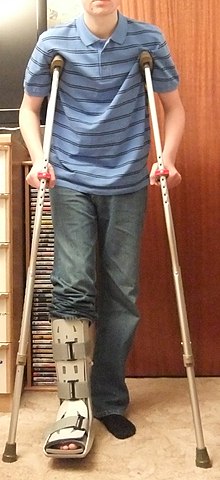Walking aid
Walking aid is the generic term for all aids that are used to relieve the strain on joints and to increase mobility .
Among the walkers include as such by the statutory health insurance (GKV) recognized tool in the context of rehabilitation , which is for varying degrees of mobility problems are many different walking aids. Walking aids also include aids used for other reasons (e.g. general relief, sporting activity , social signal ) during a form of walking (e.g. walk or hike ).
Walking aids for those with walking difficulties
Walking aids for people with walking difficulties are defined in the relevant directories and standards.
Definitions in the aids directory of the statutory health insurance
The list of resources of the statutory health insurance (GKV) distinguishes the following products:
Product group 10.46 Walking aids for the interior:
-
Walking frames
- Walking frames (rigid)
- Reciprocating walking frames (with side parts articulated against each other)
- Walking frames with two wheels
-
Walker (e.g. rollator )
- Walker
- Walker with armrests
- Walker with armpit support
- Walker for children
- Gait training devices
- Parallel bars
Product group 10.50 Walking aids for indoor and outdoor areas / road traffic:
- Hand / walking sticks
- Handsticks
- Walking sticks
- Walking sticks with anatomical handle
- Multi-foot crutches
- Multi-foot crutches with anatomical handle
-
Forearm crutches
- Forearm crutches ("crutches")
- Forearm crutches with anatomical handle
- Arthritis supports
-
Armpit supports
- Armpit supports (so-called American crutches)
-
Mobile walking aids
- Three-wheeled walking aids ( delta wheels )
- Four-wheeled walking aids ( rollators )
Product group 10.99 Walking aids without a special place of use:
- equipment
- Stock buffer
- Special stick buffer
- Cane holder
- Other walking aids
- Other walking aids
Definitions according to EN ISO 9999
The aids classification standard EN ISO 9999 differentiates between the subgroups in product group 12 - aids for personal mobility
- 12 03 Walking aids handled with one arm
- 12 03 03 walking sticks
- 12 03 06 forearm crutches
- 12 03 09 arthritis crutches
- 12 03 12 armpit supports
- 12 03 16 walking sticks with three or more support legs, a handle and / or a forearm rest or cuff
- 12 03 18 walking sticks with seat
- 12 06 Walking aids handled with both arms
- 12 06 03 walking frames / walking frames (also walking frames / walking frames with two castors)
- 12 06 06 rollators and delta walking wheels
- 12 06 09 walkers and walkers with seat (walking chair)
- 12 06 12 walker with table (walk tables)
Short individual descriptions
- Multi-foot crutches (three-point, four-point, five-point crutches) have an upper part like walking sticks, but three to five splayed individual standing points.
- Walking frames or walking frames are lightweight support frames with four support points on the floor. They are raised a little with every step and put back one step forward.
- Walkers are basically walking frames with wheels that do not have to be lifted when walking. They are mostly used indoors. Walking trolleys can be equipped with specially made orthopedic armrests as required, so that they can be used even if the ability to grip is reduced.
- Rollators are more robust and equipped with larger wheels that are suitable for outdoor use. They also have brakes, and some have seats and backrests. Similar to the rollator are deltas or tricycles, which are less stable but more agile. Orthopedic scooters are used for one-sided foot relief in the event of a temporary walking disability, e.g. B. due to a foot injury.
- Walking aids for children are manufactured as forearm walking aids with a correspondingly lower height. To promote acceptance by the young patients, these walking aids are often specially colored.
Norms
- The European standard EN ISO 11199 defines walking aids for two-arm handling and requirements and test methods.
- For Germany this standard is made out as DIN EN ISO 11199.
Walking aids for people without mobility problems
Walking aids for people without walking disabilities can be differentiated according to the purpose of their use (e.g. walking stick or hiking stick ) and according to their nature - material, manufacturing method, execution of individual individual features, etc. a. - (e.g. Bengalas de Gestaçô , Derbystock, Fritzstock , knot stick , telescopic stick , Ziegenhainer ). In the case of a differentiation (classification), special features both with regard to the intended use and with regard to the condition can come into play at the same time (e.g. with mountain sticks or with a number of other walking aids ).
Web links
Individual evidence
-
↑ Guidelines of the Federal Committee of Doctors and Health Insurance Funds on the prescription of aids in contract medical care ("Aid Guidelines"). (PDF; 134 kB) (No longer available online.) Pp. 30–32 , archived from the original on November 11, 2006 ; Retrieved August 12, 2008 . Info: The archive link was inserted automatically and has not yet been checked. Please check the original and archive link according to the instructions and then remove this notice. List of GKV aids → Product group 10: Walking aids . In: rehadat-gkv.de , Institut der Deutschen Wirtschaft Köln e. V. , as of: Federal Gazette of May 12, 2017, accessed and received on May 24, 2017.




